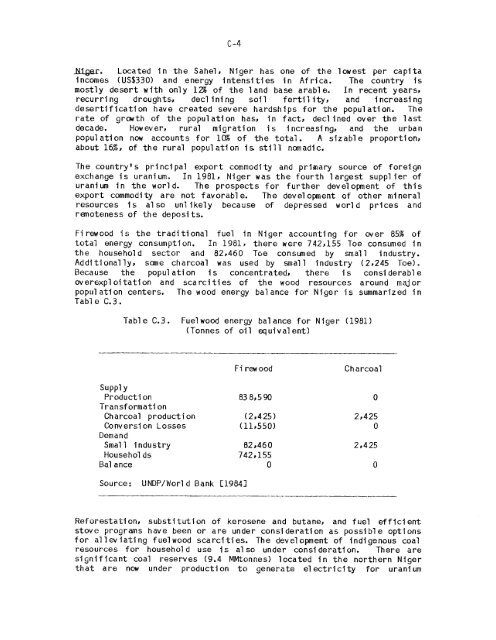Prospects for Coal Briquettes as a Substitute Fuel for Wood and ...
Prospects for Coal Briquettes as a Substitute Fuel for Wood and ...
Prospects for Coal Briquettes as a Substitute Fuel for Wood and ...
Create successful ePaper yourself
Turn your PDF publications into a flip-book with our unique Google optimized e-Paper software.
c-4<br />
Aligm. Located in the Sahel, Niger h<strong>as</strong> one of the lowest per capita<br />
incomes (US83301 <strong>and</strong> energy intensities in Africa. The country is<br />
mostly desert with only 12% of the l<strong>and</strong> b<strong>as</strong>e arable. In recent yearsI<br />
recurring droughts, decl ining sol1 fertil ity, <strong>and</strong> incre<strong>as</strong>ing<br />
desertification have created severe hardships <strong>for</strong> the population. The<br />
rate of grawth of the population h<strong>as</strong>, in factr declined over the l<strong>as</strong>t<br />
decade. HoWeverr rural migration is incre<strong>as</strong>ing, <strong>and</strong> the urban<br />
population now accounts <strong>for</strong> lQ% of the total. A sizable proportion,<br />
about 16%, of the rural populatlon is still nmadic.<br />
The country's principal export commodity <strong>and</strong> primary source of <strong>for</strong>eign<br />
exchange is uranium. In 19816 Niger w<strong>as</strong> the fourth largest supplier of<br />
uranium in the world. The prospects <strong>for</strong> further developnent of this<br />
export commodity are not favorable. The developnent of other mineral<br />
resources is a1 so unl ikely because of depressed world prices <strong>and</strong><br />
remoteness of the deposits.<br />
Firwood 1s the traditional fuel in Niger accounting <strong>for</strong> Over 85% of<br />
total energy consumptfon. In 198lS there were 74Z9155 Toe consumed in<br />
the household sector <strong>and</strong> 82,460 Toe consumed by small industry.<br />
Additionally, scme charcoal w<strong>as</strong> used by small industry (2,245 Toe).<br />
Because the popul ati on i s concentrated, there i s consi derabl e<br />
overexpl oi tation <strong>and</strong> scarcities of the woad resources around major<br />
papulation centers. The wood energy balance far Niger is summarized in<br />
Table C.3.<br />
Table C.3. <strong>Fuel</strong>wood energy balance <strong>for</strong> Niger (19811<br />
(Tonnes of 011 equivalent)<br />
Fi rew ood<br />
SUPPl Y<br />
Production 83 B,5 90<br />
Trans<strong>for</strong>mati on<br />
Charcoal production ( 294 25 1<br />
Conversion Losses (11,550)<br />
Dem<strong>and</strong><br />
Small industry 82 J46 0<br />
Househol ds 74~155<br />
Bal ance 0<br />
Charcoal<br />
0<br />
2,425<br />
0<br />
0<br />
Source:<br />
UNDP/Worl d Bank C19841<br />
Re<strong>for</strong>estati on, substi tuti on of kerosene <strong>and</strong> butane, <strong>and</strong> fuel ef fici ent<br />
stove programs have been or are under consi deration <strong>as</strong> possi bl e options<br />
<strong>for</strong> alleviating fuelwood scarcities. The developnent of indigenous coal<br />
resources <strong>for</strong> household use is also under consideration. There are<br />
significant coal reserves (9.4 MMannes) located in the northern Niger<br />
that are now under production to generate electricity <strong>for</strong> uranium

















